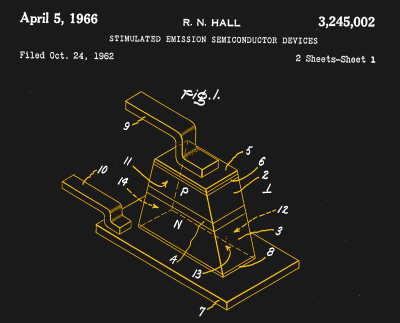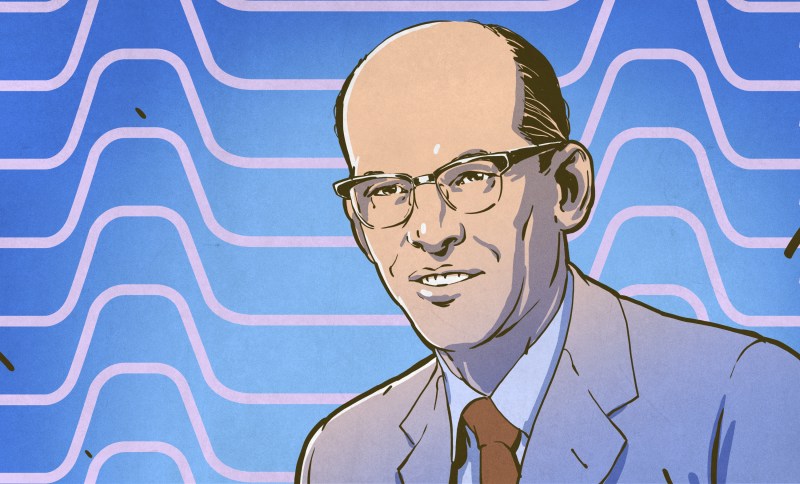The debt we all owe must be paid someday, and for inventor Robert N. Hall, that debt came due in 2016 at the ripe age of 96. Robert Hall’s passing went all but unnoticed by everyone but his family and a few close colleagues at General Electric’s Schenectady, New York research lab, where Hall spent his remarkable career.
That someone who lives for 96% of a century would outlive most of the people he had ever known is not surprising, but what’s more surprising is that more notice of his life and legacy wasn’t taken. Without his efforts, so many of the tools of modern life that we take for granted would not have come to pass, or would have been delayed. His main contribution started with a simple but seemingly outrageous idea — making a solid-state laser. But he ended up making so many more contributions that it’s worth a look at what he accomplished over his long career.
Merry Christmas

Robert Hall, given the middle name Noel in honor of his arrival on Christmas Day in 1919, was an inquisitive lad from the start. It seemed that inventing ran in the family, with his uncle Sydney being an aircraft engine designer and self-described career inventor. At a young age, his uncle took him to a sort of industrial fair in his hometown of New Haven, Connecticut, where Robert got to see all sorts of demonstrations and displays of the latest electrical innovations. His uncle explained how everything worked, which inspired young Robert to read and study as much as he could.
By the time high school rolled around, he was experimenting in a lab he built in his bedroom. He also discovered astronomy and build his own telescopes from scratch. An obviously promising student, Robert was recruited by Caltech and won a scholarship just before the start of World War II. When his funds ran out, he worked at Lockheed Aircraft, gaining valuable experience in industry and making contacts that would serve him well later.
He finally finished his physics degree in 1942 and was recruited by General Electric for their Schenectady Research Lab. As a test engineer in an industrial R&D facility during a time of war and complete national mobilization, Hall had a chance to make an impact, which he took full advantage of. Working with a team focused on using magnetrons to jam German radar, Hall’s team designed and built the first continuous-wave (CW) magnetrons. These devices would be employed during the war, but would also go on to become the heart of every microwave oven in use today. It’s even said that the possibly apocryphal story of the Raytheon engineer who was inspired to build the first microwave oven by a melting chocolate bar had his pocket zapped by one of Hall’s CW magnetrons.
Hall was encouraged to leave GE and seek his Ph.D. in physics, again from Caltech. He returned to Schenectady in 1948, ready to head up a lab of his own in the relatively new field of semiconductors. In a perfect lesson in exquisite timing, Bell Labs announced the transistor shortly after he arrived, and the whole semiconductor field exploded. GE being GE, they were mainly interested in the uses of semiconductors in power electronics, so Hall worked on high-power transistors and germanium power rectifiers. He contributed greatly to the field with innovations in purifying germanium by fractional crystallization, achieving purities that no other group was capable of. He also worked on silicon transistors, inventing two ways to dope the silicon: alloying and impurity diffusion. Pretty much every transistor ever made can trace its lineage back to those two methods.
Challenge Accepted
Hall’s innovations made GE a leader in silicon transistors by the early 1960s, and secured Hall’s place as the leading expert on semiconductors. Word came to the physics world of the invention of the laser in May of 1960, and Hall and his team devoured all the information they could get on the new field that showed so much promise. But the early lasers were complicated and fussy devices, and the need for a simpler laser was clear.
Good-natured and well-liked by his peers, Hall was teased that since he had already invented so many things, he should take a stab at a solid-state laser. Even though he thought it would be impossible, he accepted the challenge and hit the books. He knew that gallium arsenide diodes could emit enormous amounts of infrared light, so he crunched the numbers and found that he might be able to make a laser from the stuff. He put together a small team and got to work, and within just a few days, they had built a working device from a crystal only 1/3 of a millimeter on a side. It needed liquid nitrogen cooling and only worked in pulse mode, but the world finally had a laser that didn’t need pumping by an outside source of energy. The solid-state laser had arrived.

The GE team wrote up their results quickly and submitted a paper to the Physical Review Letters. Sadly, some chicanery resulted when the paper was sent out for peer review. Two of the reviewers were from two different competing corporate labs working on solid-state lasers, and when they read of Hall’s success, they short-circuited the process and held a press conference to announce that they had “invented” the solid-state laser. Luckily, Hall’s patent was granted along with the others; in any event, his team was the first to publish, so there’s little doubt as to the fatherhood of the solid-state laser.
Hall continued working at GE until his retirement, racking up 43 patents and 81 publications. His other work impacted the fields of nuclear physics, where his high-purity semiconductors are used for sensitive gamma-ray detectors. And while GE never developed Hall’s laser into a commercial product — the work of building a continuous-wave room-temperature solid-state laser was left to others — every single point-of-sale barcode scanner, CD player, laser pointer, and perhaps most importantly, every fiber optic connection that would eventually stitch together the backbone of the Internet, all trace back to that tiny crystal on Robert Hall’s lab bench in 1962.

















I think most people would call the ruby laser solid state because the gain medium is solid state.
Still has to be pumped by an outside photon source. Doesn’t really count.
” Semiconductor-based lasers are also in the solid state, but are generally considered as a separate class from solid-state lasers (see Laser diode).”
From https://en.wikipedia.org/wiki/Solid-state_laser
I’m not saying Wikipedia is the authority, but this matches my understanding; Solid state came first and when semiconductor lasers came along they had their own class because they worked differently.
Wikipedia not being a reliable source of information was a conspiracy started by teachers who want their students to suffer more while doing research assignments.
B^)
Yeah, the way my teacher worded it helped:
“Wikipedia is a reliable source of information only if you verify the citations and ensure they are valid, like you would with any scientific paper”
Last week I reluctantly threw out that last of the two sets of encyclopedias, I was thinking I could restore from water damage, that I grew up with. I literally think (other than saving space for storage, accessibility and per review ability to verify and correct or expand) some days that there could be an almost “book burning” conspiracy going on. I doubt that… though I do wonder on some days the electronic media and systems inability to critical concentrate as easily as with less noise, static, interference and jamming as with printed media and mechanical/pneumatic/hydraulic systems.
High school only here, but I always just ignored that. Teachers didn’t care so long you had good presentation and the first few sentences made sense
Wikipedia is not the authority but it’s got this one right. We call all Lasers that the lasing medium is solid: “solid state lasers” regardless of the source of the energy. Semiconductor lasers on the other hand, are a category of their own. This is according to the standard authority in the US: LIA ANSI Z136.1
Diode laser are also the heart of many industrial lasers now. Gone are the days of arc lamps or flash lamps, pretty much everything outside of the CO2 laser realm is Diode Pumped Solid State. With 4th and 5th harmonic generation you can get into the territory that used to be exclusive to excimer and N2 lasers, deep UV. Excimer and N2 still have the highest pulse energies though.
Fiber lasers which are diode pumped are also taking over a lot of the CO2 lasers territory. Almost zero maintenance and simplified beam path since the fiber is the gain medium means simoler and cheaper machine design. Higher efficiency means you don’t need a massive chiller to keep the laser cool too.
So, yeah, diode lasers have changed things big time, especially in the past 15-20 years.
Hi, I followed a course on optics and quantum electronics when studying physics, but I regularly find a mismatch between my conception of what I know has been done in the lab, and what is available affordably.
For an experiment I am interested in deep UV lasers, how affordable are the 4/5th harmonic generation lasers? Can you point me to some sellers or perhaps industry keywords or jargon?
A nice biography of R. Hall, who, as was mentioned, has otherwise received little fanfare due to the nature of his contributions to the scientific community (that is to say, not that many–he was a manger in a large company not unlike the many unsung heroes of today).
That said, his role in the laser’s history is considerably more complicated than what his wikipedia article might suggest. Due to the enormous significance of the laser in the modern day, and huge number of people who contributed to its invention, there will always be contention as to exactly ‘who did what’. R. Hall (not to be confused with the other Halls, such as the notable E. Hall of the Hall Effect) claims to have been the first to see laser light emitted from a semiconductor laser (lets not even start on the glaring error in the title of being the first ‘solid state laser’ which had been demonstrated years before the first semiconductor laser). This claim is contested by other companies, most notably IBM who claims[1] that they had a working device before Hall did at GE. In fact they published a paper on their results a week after GE did, so it is clear why one could contest as to who was the first to demonstrate lasing in a semiconductor device.
I argue the reason that several teams made the ‘discovery’ at roughly the same time is that they were both working off the theoretical work done by the real brains of the operation working at MIT, IBM, TI, RCA, etc, who had published how to get lasing from a semiconductor well before the experimental verification.
Furthermore, the experimental results from Hall at GE and others in the early 60’s are hardly related to modern semiconductor lasers, being basically a lump of bulk semiconductor material with an absurdly high current flowing through it, with the terrible optical performance one might expect for what was basically a rectifier diode driven with such current density that it started to glow. Modern diodes are epitaxially grown heterostructures based on quantum confinement which had been theorized by H. Kroemer at RCA in the ’50s[2] and demonstrated in the early 70’s roughly simultaneously by teams both in Russia and the US.
[1]https://aip.scitation.org/doi/pdf/10.1063/1.1777371
[2]https://web.ece.ucsb.edu/Faculty/Kroemer/pubs/1a_57Quasi_Electric.pdf
Let’s not forget Monty Hall and his great contribution to Probability Theory!
B^)
A minor correction. NOT every single point-of-sale barcode scanner uses a laser diode. For many years both supermarket scanners, and also handheld barcode scanners, used small Helium-Neon laser tubes.